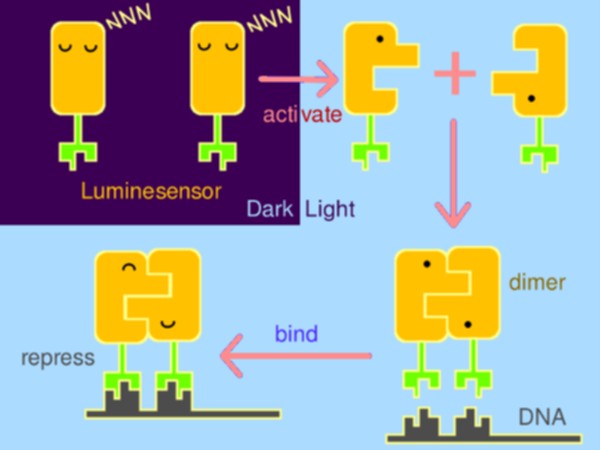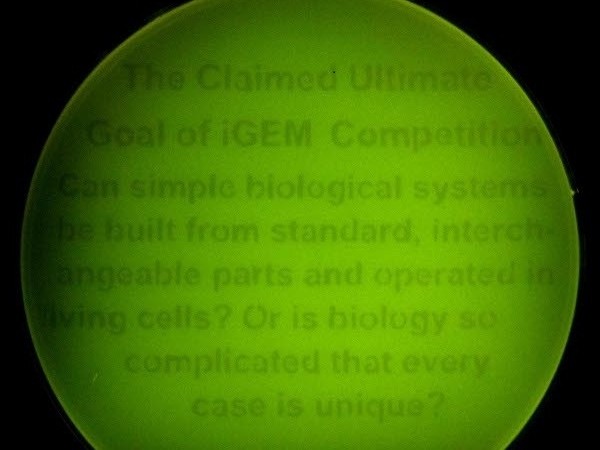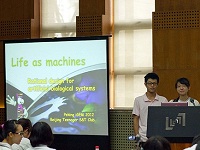Team:Peking
From 2012.igem.org
| (53 intermediate revisions not shown) | |||
| Line 547: | Line 547: | ||
<li> | <li> | ||
<ul onmouseover="TriggerSubmenu(1);" onmouseout="TriggerSubmenu(0);" class="vertical" style="width:120px;display:block;"> | <ul onmouseover="TriggerSubmenu(1);" onmouseout="TriggerSubmenu(0);" class="vertical" style="width:120px;display:block;"> | ||
| - | |||
| - | |||
| - | |||
| - | |||
| - | |||
<li class="submenu_team"> | <li class="submenu_team"> | ||
<a href="/Team:Peking/Team/Members"> | <a href="/Team:Peking/Team/Members"> | ||
Members | Members | ||
| - | |||
| - | |||
| - | |||
| - | |||
| - | |||
</a> | </a> | ||
</li> | </li> | ||
| Line 626: | Line 616: | ||
<li class="submenu_modeling"> | <li class="submenu_modeling"> | ||
<a href="/Team:Peking/Modeling/Luminesensor"> | <a href="/Team:Peking/Modeling/Luminesensor"> | ||
| - | Luminesensor | + | Luminesensor |
</a> | </a> | ||
</li> | </li> | ||
| Line 634: | Line 624: | ||
</a> | </a> | ||
</li> | </li> | ||
| - | + | <li class="submenu_modeling"> | |
| - | <a href="/Team:Peking/Modeling/ | + | <a href="/Team:Peking/Modeling/Ring"> |
| - | + | Ring Pattern | |
</a> | </a> | ||
| - | </li | + | </li> |
</ul> | </ul> | ||
</li> | </li> | ||
| Line 676: | Line 666: | ||
var Submenu_Item_Cur = 0; | var Submenu_Item_Cur = 0; | ||
var Submenu_BlankWidth = [0, 318, 360, 465, 528, 612]; //Unit: Pixel | var Submenu_BlankWidth = [0, 318, 360, 465, 528, 612]; //Unit: Pixel | ||
| - | + | var Submenu_ListHeight = [130, 75, 125, 50, 100, 75]; //Unit: Pixel | |
| - | + | ||
var Submenu_Handle_State = 0; //0:Null, 1:Growth, 2:Waiting, 3:Wither | var Submenu_Handle_State = 0; //0:Null, 1:Growth, 2:Waiting, 3:Wither | ||
var Submenu_Handle = null; | var Submenu_Handle = null; | ||
| Line 820: | Line 809: | ||
<div id="text-body"> | <div id="text-body"> | ||
<div class="floatR"> | <div class="floatR"> | ||
| - | <div style="float:left;"><p style="font-size:45px;line-height:45px;color:#ffffff;margin:20px 3px 0 20px;"> | + | <div style="float:left;"><p style="font-size:45px;line-height:45px;color:#ffffff;margin:20px 3px 0 20px;">L</p></div> |
<p class="context_block" style="width:610px;"> | <p class="context_block" style="width:610px;"> | ||
| - | + | ight has created innumerable wonders in nature. Equipped with tools and methods in optogenetic research, scientists have also achieved some truly fascinating goals in a synthetic way. This year, 2012 Peking-ECUST iGEM utilized an ultra-sensitive engineered sensor of luminescence -- the <b style="color:#ffee55;"> <i>Luminesensor</i></b>. Amazingly, the <i>Luminesensor</i> was proven to be so sensitive as to be able to detect <b style="color:#ffee55;">natural light</b> and even <b style="color:#ffee55;">bioluminescence</b>. With this sensor, spatiotemporal control of cellular behavior, such as <b style="color:#ffee55;">high-resolution 2D</b> and <b style="color:#ffee55;">3D bio-printing</b> using dim light and even the <b style="color:#ffee55;">luminescence of iPad</b> were shown to be very easy. What’s more, we successfully implemented <b style="color:#ffee55;">cell-cell signaling using light</b> for the very first time in synthetic biology, which will be of great importance for biotechnological use. | |
</p> | </p> | ||
</div> | </div> | ||
| - | <div class="floatL" style="margin:0 10px 5px 0;"><table class="title_block" style="background-image:url('/wiki/images/b/be/Peking2012_Color_Title_AquaBlue.jpg');"><tr><td style="height: | + | <div class="floatL" style="margin:0 10px 5px 0;"><table class="title_block" style="background-image:url('/wiki/images/b/be/Peking2012_Color_Title_AquaBlue.jpg');"><tr><td style="height:244px;"><p style="font-size:36px;">Abstract</p></td></tr></table></div> |
| - | + | ||
<div class="floatC"><p style="height:30px;"></p></div> | <div class="floatC"><p style="height:30px;"></p></div> | ||
<div class="floatL"> | <div class="floatL"> | ||
| Line 832: | Line 821: | ||
<div class="floatR"><img src="/wiki/images/4/4f/Peking2012_LuminesensorMechanism.jpg" alt="" style="width:200px;"/></div> | <div class="floatR"><img src="/wiki/images/4/4f/Peking2012_LuminesensorMechanism.jpg" alt="" style="width:200px;"/></div> | ||
<div class="floatC"><p class="context_block" style="width:360px;"> | <div class="floatC"><p class="context_block" style="width:360px;"> | ||
| - | Strongly motivated to open up a new era of optogenetics, | + | Strongly motivated to open up a new era of optogenetics, our team has utilized an ultra-sensitive sensor which is engineered for sensing luminance – named by us <i>Luminesensor</i>, enabling highly efficient spatiotemporal control of biochemical process or cellular behavior. The whole job serves as a paradigm for sensor creating. |
</p></div> | </p></div> | ||
</div> | </div> | ||
| Line 839: | Line 828: | ||
<div class="floatR"><img src="/wiki/images/7/77/Peking2012_LightCommunication.jpg" alt="" style="width:200px;"/></div> | <div class="floatR"><img src="/wiki/images/7/77/Peking2012_LightCommunication.jpg" alt="" style="width:200px;"/></div> | ||
<div class="floatC"><p class="context_block" style="width:360px;"> | <div class="floatC"><p class="context_block" style="width:360px;"> | ||
| - | The | + | The <i>Luminesensor</i> is able to respond to very low light and meanwhile keep a wide dynamic range, which encouraged us to explore the possibility of cell-cell communication through light. We have successfully implemented, for the very first time, light-communication among cells without direct physical contact. |
</p></div> | </p></div> | ||
</div> | </div> | ||
| Line 847: | Line 836: | ||
<div class="floatR"><img src="/wiki/images/b/b1/Peking2012_PrintParagraph_Square_Edit.jpg" alt="" style="width:200px;"/></div> | <div class="floatR"><img src="/wiki/images/b/b1/Peking2012_PrintParagraph_Square_Edit.jpg" alt="" style="width:200px;"/></div> | ||
<div class="floatC"><p class="context_block" style="width:360px;"> | <div class="floatC"><p class="context_block" style="width:360px;"> | ||
| - | 3D printing is a new technology that has been rising for many years. But in the realm of synthetic biology, it is far from developed. We exploited our <i>Luminesensor</i> to implement 3D printing that can be utilized in many | + | 3D printing is a new technology that has been rising for many years. But in the realm of synthetic biology, it is far from developed. We exploited our <i>Luminesensor</i> to implement 3D printing that can be utilized in many medical or manufacturing applications. |
</p></div> | </p></div> | ||
</div> | </div> | ||
| Line 854: | Line 843: | ||
<div class="floatR"><img src="/wiki/images/d/d5/Peking2012_CartoonPhototaxis_Edit.jpg" alt="" style="width:200px;"/></div> | <div class="floatR"><img src="/wiki/images/d/d5/Peking2012_CartoonPhototaxis_Edit.jpg" alt="" style="width:200px;"/></div> | ||
<div class="floatC"><p class="context_block" style="width:360px;"> | <div class="floatC"><p class="context_block" style="width:360px;"> | ||
| - | "Phototatic" bacteria can be built by programming the chemotaxis system in <i>E. coli</i> through light. By controlling the expression level of the CheZ protein with <i>Luminesensor</i>, the tumbling frequency is coupled to the intensity of light signals. | + | "Phototatic" bacteria can be built by programming the chemotaxis system in <i>E. coli</i> through light. By controlling the expression level of the CheZ protein with the <i>Luminesensor</i>, the tumbling frequency is coupled to the intensity of light signals. |
</p></div> | </p></div> | ||
</div> | </div> | ||
| Line 862: | Line 851: | ||
<div class="floatR"><img src="/wiki/images/8/82/Peking2012_Lecture000_Edit.jpg" alt="" style="width:200px;"/></div> | <div class="floatR"><img src="/wiki/images/8/82/Peking2012_Lecture000_Edit.jpg" alt="" style="width:200px;"/></div> | ||
<div class="floatC"><p class="context_block" style="width:360px;"> | <div class="floatC"><p class="context_block" style="width:360px;"> | ||
| - | We have done a remarkable job in motivating high school students to study synthetic biology and guiding them towards future participation in the iGEM high school division. Besides, we collaborated with a lab and helped | + | We have done a remarkable job in motivating high school students to study synthetic biology and guiding them towards future participation in the iGEM high school division. Besides, we collaborated with a lab and helped four other iGEM teams by sharing DNA materials, characterizing their parts and modeling. Furthermore, we presented all fresh iGEMers with a collection of praise for historic iGEM projects. |
</p></div> | </p></div> | ||
</div> | </div> | ||
| Line 869: | Line 858: | ||
<div class="floatR"><img src="/wiki/images/a/a8/Peking2012_PhototaxisSPECSdot_Edit.gif" alt="" style="width:200px;"/></div> | <div class="floatR"><img src="/wiki/images/a/a8/Peking2012_PhototaxisSPECSdot_Edit.gif" alt="" style="width:200px;"/></div> | ||
<div class="floatC"><p class="context_block" style="width:360px;"> | <div class="floatC"><p class="context_block" style="width:360px;"> | ||
| - | Excellent stochastic simulation was conducted to | + | Excellent stochastic simulation was conducted to describe our ultrasensitive <i>Luminesensor</i>, combining protein kinetics and reaction thermodynamics. Molecular docking was also operated. What's more, while designing our photo-taxis model, we developed a hexagonal-coordinate environment for dynamic simulation of "on-plate" system. Those who focus on cell motility will find it useful and inspirational. |
</p></div> | </p></div> | ||
</div> | </div> | ||
Latest revision as of 20:16, 26 October 2012
L
ight has created innumerable wonders in nature. Equipped with tools and methods in optogenetic research, scientists have also achieved some truly fascinating goals in a synthetic way. This year, 2012 Peking-ECUST iGEM utilized an ultra-sensitive engineered sensor of luminescence -- the Luminesensor. Amazingly, the Luminesensor was proven to be so sensitive as to be able to detect natural light and even bioluminescence. With this sensor, spatiotemporal control of cellular behavior, such as high-resolution 2D and 3D bio-printing using dim light and even the luminescence of iPad were shown to be very easy. What’s more, we successfully implemented cell-cell signaling using light for the very first time in synthetic biology, which will be of great importance for biotechnological use.
Abstract |

Strongly motivated to open up a new era of optogenetics, our team has utilized an ultra-sensitive sensor which is engineered for sensing luminance – named by us Luminesensor, enabling highly efficient spatiotemporal control of biochemical process or cellular behavior. The whole job serves as a paradigm for sensor creating.

The Luminesensor is able to respond to very low light and meanwhile keep a wide dynamic range, which encouraged us to explore the possibility of cell-cell communication through light. We have successfully implemented, for the very first time, light-communication among cells without direct physical contact.

3D printing is a new technology that has been rising for many years. But in the realm of synthetic biology, it is far from developed. We exploited our Luminesensor to implement 3D printing that can be utilized in many medical or manufacturing applications.

"Phototatic" bacteria can be built by programming the chemotaxis system in E. coli through light. By controlling the expression level of the CheZ protein with the Luminesensor, the tumbling frequency is coupled to the intensity of light signals.

We have done a remarkable job in motivating high school students to study synthetic biology and guiding them towards future participation in the iGEM high school division. Besides, we collaborated with a lab and helped four other iGEM teams by sharing DNA materials, characterizing their parts and modeling. Furthermore, we presented all fresh iGEMers with a collection of praise for historic iGEM projects.

Excellent stochastic simulation was conducted to describe our ultrasensitive Luminesensor, combining protein kinetics and reaction thermodynamics. Molecular docking was also operated. What's more, while designing our photo-taxis model, we developed a hexagonal-coordinate environment for dynamic simulation of "on-plate" system. Those who focus on cell motility will find it useful and inspirational.
 "
"















